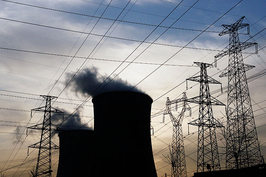Beijing Lowers This Year’s Goal for Cutting Excess Coal Production

(Beijing) — China’s goal to reduce excess coal capacity will be far less ambitious this year — only 20% of last year’s target — because scaling back coal production is expected to be increasingly difficult due to rising prices and concerns over lost jobs.
The government aims to close down coal mines representing a combined annual production capacity of 50 million tons, the National Energy Administration (NEA) said in its directives for energy work in 2017, published Friday. The number is far less than the 250-million-ton goal set for last year.
“Coal capacity certainly remains excessive, (but) the annual-capacity reduction target cannot be set at a very high level every year,” He Yongjian, a deputy chief of the NEA’s planning department, which drafted the directives, told Caixin on Saturday. He added that the government plans to shutter more than 500 coal mines this year.
Last year’s overcapacity reduction goal was exceeded by the actual shutdown of about 300 million tons in coal capacity. But many of those mines had already been producing less or had even suspended operation, officials have said.
The campaign is expected to be much more complicated this year because more operating mines will be affected. That means more workers are to be laid off and the government will face the daunting task to create new jobs to maintain social stability.
Jiang Zhimin, a deputy head of industry group China National Coal Association, said last month that helping laid-off miners find new jobs will be a key issue for 2017’s drive to cut excess capacity.
Soaring coal prices — driven by a supply crunch due to capacity removals and other production restrictions last year — are also likely to tempt coal mine owners to actually rev up output. The NEA expected coal output will rise 5.8% this year compared with 2016 to 3.65 billion tons, which will mark an end to a three-year streak in declining output.
“Policymaking and implementation have likely become more measured after supply turned extremely tight and prices surged last year,” Liu Xiaomin, an analyst with research firm IHS Markit, told Caixin on Monday.
“This year’s target may look small. But such a prudent and more pragmatic goal is more meaningful taking into consideration last year’s production, supply and demand and the situation (the industry is facing) this year,” he said.
The Chinese government plans to shed 800 million tons of inefficient coal-mining capacity and 140 million tons of excess steel capacity within three to five years from 2016 to “restore healthier fundamentals to those industries,” Premier Li Keqiang said in an article published last month on Bloomberg Businessweek.
In addition, last March it carried out a policy to slash the number of annual working days at coal mines by 16%, which immediately caused monthly production in the following seven months to fall on average by 10%.
Prices jumped in the second half of last year, with the benchmark freight on board price of a thermal coal traded at northern China’s Qinhuangdao port gaining 72.7% to 639 yuan ($93) per ton at the end of 2016 from the start of the year.
Authorities were forced to backtrack on the working-day limits and in November revoked the ruling by allowing mines that meet “work-safety standards” to resume normal operation to increase output until March, when the heating season ends.
Nonetheless, demand for coal in China is seen to be on a downward trajectory over the long term as the country seeks cleaner sources of fuel to power its economy amid mounting public concerns over pollution.
The southern province of Guangdong has vowed to trim coal consumption in the Pearl River Delta, a major industrial powerhouse in China, by 12% by 2020 from the level in 2013, according to the provincial government’s energy development plan for 2016-20.
It also banned the construction of new coal-fired power plants or the expansion of existing facilities in the area, in an apparent bid to address a supply glut. Figures from industry group China Electricity Council showed that about a third of Guangdong’s coal-burning power generators were not used in 2016.
In stark contrast, the province plans to more than triple the installed capacity of wind farms to eight gigawatts (GW) by 2020 from 2015, and increase that of solar power by more than seven times over the period to 6 GW.
Contact reporter Fran Wang (fangwang@caixin.com)

- 1China Moves to Tighten Air-Quality Standards as Beijing Reports Best-Ever Skies
- 2China Threatens EU After Carbon Border Tax Takes Effect
- 3Gansu Ex-Vice Governor Jailed 15 Years for Bribery, Insider Trading
- 4 Exclusive: Wingtech Chair Vows to Regain Control of Nexperia After 100-Day Standoff
- 5Cover Story: How Resource Nationalism Is Redrawing the Global Mineral Playbook
- 1Power To The People: Pintec Serves A Booming Consumer Class
- 2Largest hotel group in Europe accepts UnionPay
- 3UnionPay mobile QuickPass debuts in Hong Kong
- 4UnionPay International launches premium catering privilege U Dining Collection
- 5UnionPay International’s U Plan has covered over 1600 stores overseas





